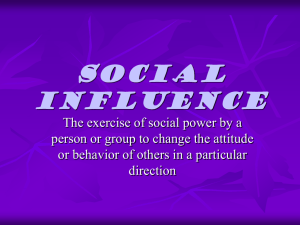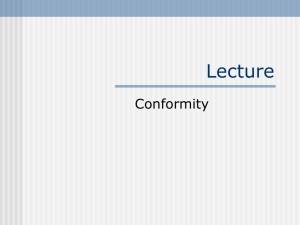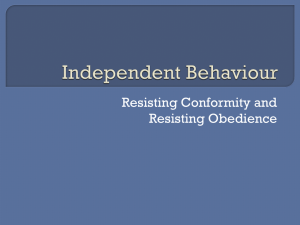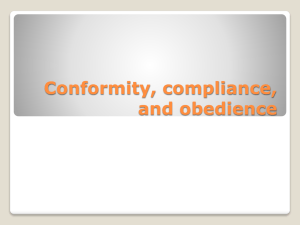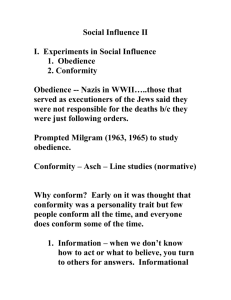Conformity
advertisement
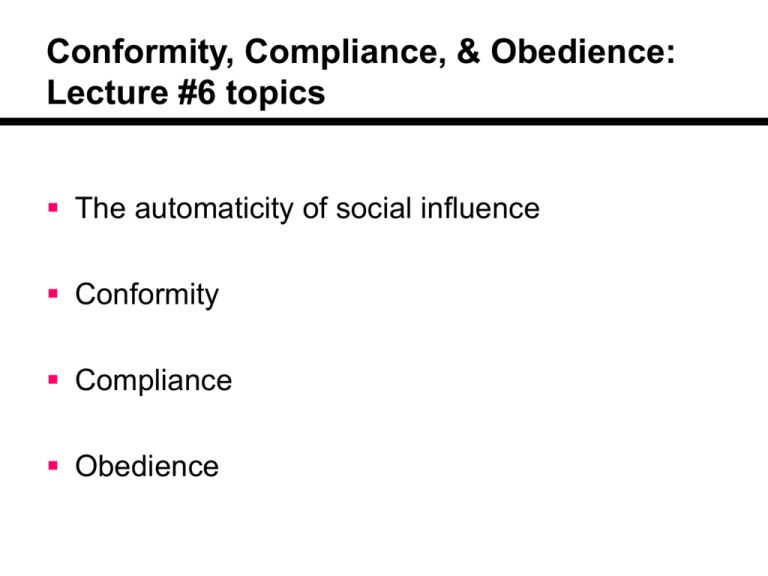
Conformity, Compliance, & Obedience: Lecture #6 topics The automaticity of social influence Conformity Compliance Obedience The automaticity of social influence social influence: the ways in which we are affected by the real/ imagined _________ of other people we are vulnerable to subtle influences e.g., _________, _________ effects occur within 72 hours of birth The automaticity of social influence HIGH LOW Frequency of participant's actions Chartrand & Bargh (1999): Participant rubs face Participant taps foot Confederate rubs face Confederate taps foot The automaticity of social behaviour the _________ effect (non-conscious mimicry): _________ mimicking people’s subtle actions _________ our social interactions with them evidence: when a confederate mimicked them, participants liked him _________ Conformity conformity: changing our perceptions, opinions, & behaviour to be _________ with _________ social norms are difficult to violate e.g., wearing jeans to a wedding Conformity SHERIF’S (1936) “AUTOKINETIC EFFECT” STUDY: individual session dot of light appeared before participant in darkened room task: estimate the distance the light had moved group sessions same procedure, except participants worked in groups of 3 over 3 sessions after a few trials, their estimates converged on their own _________ norms after a few trials, participants’ estimates converged on a _________ norm Conformity Distance estimates Sherif (1936): Participant 1 Participant 2 Participant 3 Individual Session Group Session 1 Group Session 2 Group Session 3 individual estimates converged on group norm Conformity ASCH’S (1951) “LINE JUDGMENT” STUDY: participants either worked alone or with 6 other “participants” (confederates) task: announce which of 3 comparison lines (X, Y, Z) was same length as target line (A) Conformity Is A the same length as X, Y, or Z? A X Y Z Conformity Asch (1951): LOW # of incorrect judgments HIGH Alone 6-person group Conformity WHY DO PEOPLE CONFORM? informational influence desire to be correct, esp. when physical reality is ambiguous leads to _________ (_________): changes in both outward behaviour & inward beliefs normative influence desire to avoid social deviance & to be accepted e.g., _________ study; religious converts e.g., _________ study; politicians leads to _________ (_________): change in outward behaviour but not inward beliefs Conformity The difference between private & public conformity: people who have _________ conformed maintain that change _________ participants maintained normative group estimates up to 1 year following original study people who have _________ conformed do not maintain that change _________ participants’ conformity dropped when they wrote their answers in private Conformity FACTORS INFLUENCING CONFORMITY group size: conformity increases with group size up to a certain point beyond _________ people, additional influence is negligible Conformity FACTORS INFLUENCING CONFORMITY having an ally: any dissent—whether it validates your opinion or not—is enough to break normative pressures to conform Conformity minority influence: process by which dissenters can bring about change in a group most influential when they are _________ , _________ , & _________ _________ shows that they are unwilling to yield, forcing majority to compromise Compliance the language of request: mindlessness can _________ compliance e.g., Langer (1978): butting in line for the photocopier mindlessness can _________ compliance e.g., ignoring panhandlers compliance can be increased by unusual requests (“spare some change” vs. “spare 17¢”) Compliance _________: we should treat others as they’ve treated us we feel obligated to comply with people’s requests as repayment e.g., Regan’s (1971) “pop” study wait staff write “thank you” on bills to increase tips Compliance SEQUENTIAL REQUEST STRATEGIES foot-in-the-door technique: break the ice with a small request that can’t be refused, then follow up with a bigger request e.g., Freedman & Fraser (1966) _________ study Conformity Freedman & Fraser (1966): Compliance rate HIGH LOW No phone survey; outrageous request only Phone survey first, then outrageous request Conformity SEQUENTIAL REQUEST STRATEGIES (cont’d) low-ball technique: committing to an attractive proposition before hidden costs are revealed once you’ve committed yourself to a decision, you justify it to yourself & resist changing your mind Conformity SEQUENTIAL REQUEST STRATEGIES (cont’d) door-in-the-face technique: _________ of a large initial request, followed by a second, more _________ request e.g., taking juvenile delinquents to the zoo Compliance Compliance rate HIGH LOW Modest request only Large request, followed by modest request Compliance WHY DOES DOOR-IN-THE-FACE WORK? _________: _________ request seems smaller than larger, _________ request, so we concede _________: when someone backs down from a large request, we respond by conceding to the smaller request Obedience obedience: behaviour change produced by the commands of authority figures Adolf Eichmann Obedience Milgram’s (1963) obedience study: 75 to 105 volts 120 volts 150 volts 330 volts Obedience psychiatrists, university students, & middle-class adults predicted that: they would quit at _________ other people would quit at _________ psychiatrists also predicted that _________ people would go all the way to 450 volts Obedience Milgram’s (1963) results: Participants who stopped at this level Shock level (volts) # participants /40 % of participants 300 5 12.5 315 330 345 360 4 2 1 1 10 5 2.5 2.5 375 450 1 2.5 Obedience what makes a person so obedient? the _________ personality: ethnocentric, intolerant of dissent, punitive _________ to authority figures; _________ to “subordinates” more likely to administer higher shock levels Obedience SITUATIONAL FACTORS TO CONSIDER the authority figure: his _________ & *apparent* legitimacy influenced obedience obedience dropped when: experiment moved from Yale to rundown building (___%) experimenter was replaced by a “participant” (___%) experimenter issued commands by phone (___%) Obedience the victim: participants were _________ from the student could maintain emotional distance from the consequences of their actions obedience rates dropped when: participants sat in same room as student (___%) participants had to hold student’s hand down on shock plate (___%) Obedience the procedure: participants didn’t feel personally _________ because experimenter _________ obedience dropped when participants thought they were personally responsible _________ escalation of commitment couldn’t escape the situation once they realized what they were doing (_________) similar to how torturers of political prisoners are trained Defiance disobedience is a _________ act: having just 1 ally/ dissenter is enough to give people courage to dissent as well obedience dropped when participant was joined by ___ co-teachers who refused to continue (___%)

